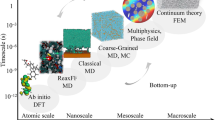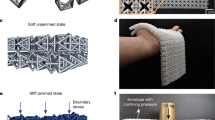Abstract
Rubbers reinforced with rigid particles are used in high-volume applications, including tyres, dampers, belts and hoses1. Many applications require high modulus to resist excessive deformation and high fatigue threshold to resist crack growth under cyclic load. The particles are known to greatly increase modulus but not fatigue threshold. For example, adding carbon particles to natural rubber increases its modulus by one to two orders of magnitude1,2,3, but its fatigue threshold, reinforced or not, has remained approximately 100 J m−2 for decades4,5,6,7. Here we amplify the fatigue threshold of particle-reinforced rubbers by multiscale stress deconcentration. We synthesize a rubber in which highly entangled long polymers strongly adhere with rigid particles. At a crack tip, stress deconcentrates across two length scales: first through polymers and then through particles. This rubber achieves a fatigue threshold of approximately 1,000 J m−2. Mounts and grippers made of this rubber bear high loads and resist crack growth over repeated operation. Multiscale stress deconcentration expands the space of materials properties, opening doors to curtailing polymer pollution and building high-performance soft machines.
This is a preview of subscription content, access via your institution
Access options
Access Nature and 54 other Nature Portfolio journals
Get Nature+, our best-value online-access subscription
$29.99 / 30 days
cancel any time
Subscribe to this journal
Receive 51 print issues and online access
$199.00 per year
only $3.90 per issue
Buy this article
- Purchase on Springer Link
- Instant access to full article PDF
Prices may be subject to local taxes which are calculated during checkout




Similar content being viewed by others
Data availability
The cyclic stress–stretch curves and energy release rates as a function of stretch for all synthesis conditions, as well as the Arduino code for the fatigue testers, are provided in the Supplementary Information. Raw monotonic and cyclic stress–stretch curves are available from the corresponding authors on request.
References
GentA. N. Engineering with Rubber: How to Design Rubber Components (Carl Hanser, 2012).
Wang, M.-J. Effect of polymer-filler and filler-filler interactions on dynamic properties of filled vulcanizates. Rubber Chem. Technol. 71, 520–589 (1998).
Heinrich, G. & Klüppel, M. Recent advances in the theory of filler networking in elastomers. Adv. Polym. Sci. 160, 1–44 (2002).
Lake, G. J. & Thomas, A. G. The strength of highly elastic materials. Proc. Royal Soc. Lond. Ser. Math. Phys. Sci. 300, 108–119 (1967).
Robertson, C. G., Stoček, R. & Mars, W. V. The fatigue threshold of rubber and its characterization using the cutting method. Adv. Polym. Sci. 286, 57–84 (2020).
Gent, A. N., Lai, S.-M., Nah, C. & Wang, C. Viscoelastic effects in cutting and tearing rubber. Rubber Chem. Technol. 67, 610–618 (1994).
Robertson, C. G., Stoček, R., Kipscholl, C. & Mars, W. V. Characterizing the intrinsic strength (fatigue threshold) of natural rubber/butadiene rubber blends. Tire Sci. Technol. 47, 292–307 (2019).
Rubinstein, M. & Colby, R. H. Polymer Physics (Oxford Univ. Press, 2003).
Kim, J., Zhang, G., Shi, M. & Suo, Z. Fracture, fatigue, and friction of polymers in which entanglements greatly outnumber cross-links. Science 374, 212–216 (2021).
Andreozzi, L., Castelvetro, V., Faetti, M., Giordano, M. & Zulli, F. Rheological and thermal properties of narrow distribution poly(ethyl acrylate)s. Macromolecules 39, 1880–1889 (2006).
Guth, E. & Gold, O. On the hydrodynamical theory of the viscosity of suspensions. Phys. Rev. 533, 322 (1938).
Guth, E. Theory of filler reinforcement. Rubber Chem. Technol. 18, 596–604 (1945).
Bergström, J. S. & Boyce, M. C. Mechanical behavior of particle filled elastomers. Rubber Chem. Technol. 72, 633–656 (1999).
Sotta, P. et al. Nonentropic reinforcement in elastomer nanocomposites. Macromolecules 50, 6314–6322 (2017).
Torquato, S. Random Heterogeneous Materials (Springer, 2002).
Payne, A. R. The dynamic properties of carbon black-loaded natural rubber vulcanizates. Part I. J. Appl. Polym. Sci. 6, 57–63 (1962).
Laschi, C., Mazzolai, B. & Cianchetti, M. Soft robotics: technologies and systems pushing the boundaries of robot abilities. Sci. Robot. 1, eaah3690 (2016).
Hawkes, E. W., Majidi, C. & Tolley, M. T. Hard questions for soft robotics. Sci. Robot. 6, eabg6049 (2021).
Yang, Y., Vella, K. & Holmes, D. P. Grasping with kirigami shells. Sci. Robot. 6, eabd6426 (2021).
Hu, P., Madsen, J. & Skov, A. L. One reaction to make highly stretchable or extremely soft silicone elastomers from easily available materials. Nat. Comm. 13, 370 (2022).
Sanoja, G. E. et al. Why is mechanical fatigue different from toughness in elastomers? The role of damage by polymer chain scission. Sci. Adv. 7, eabg9410 (2021).
Zhang, W. et al. Fatigue of double-network hydrogels. Eng. Fract. Mech. 187, 74–93 (2018).
Ducrot, E., Chen, Y., Bulters, M., Sijbesma, R. P. & Creton, C. Toughening elastomers with sacrificial bonds and watching them break. Science 344, 186–189 (2014).
Gong, J. P., Katsuyama, Y., Kurokawa, T. & Osada, Y. Double-network hydrogels with extremely high mechanical strength. Adv. Mater. 15, 1155–1158 (2003).
Zhou, Y. et al. Flaw-sensitivity of a tough hydrogel under monotonic and cyclic loads. J. Mech. Phys. Solids 153, 104483 (2021).
Persson, B. N. J., Albohr, O., Heinrich, G. & Ueba, H. Crack propagation in rubber-like materials. J. Phys. Condens. Matter 17, R1071 (2005).
Creton, C. & Ciccotti, M. Fracture and adhesion of soft materials: a review. Rep. Prog. Phys. 79, 046601 (2016).
Scetta, G. et al. Self-organization at the crack tip of fatigue-resistant thermoplastic polyurethane elastomers. Macromolecules 54, 8726–8737 (2021).
Scetta, G. et al. Strain induced strengthening of soft thermoplastic polyurethanes under cyclic deformation. J. Polym. Sci. 59, 685–696 (2021).
Wang, Z. et al. Stretchable materials of high toughness and low hysteresis. Proc. Natl Acad. Sci. USA 116, 5967–5972 (2019).
Cui, W. et al. Fiber-reinforced viscoelastomers show extraordinary crack resistance that exceeds metals. Adv. Mater. 32, 1907180 (2020).
Fleck, N. A., Kang, K. J. & Ashby, M. F. The cyclic properties of engineering materials. Acta Metall. Mater. 42, 365–381 (1994).
Berriot, J., Martin, F., Montes, H., Monnerie, L. & Sotta, P. Reinforcement of model filled elastomers: characterization of the cross-linking density at the filler–elastomer interface by 1H NMR measurements. Polymer 44, 1437–1447 (2003).
Berriot, J. et al. Reinforcement of model filled elastomers: synthesis and characterization of the dispersion state by SANS measurements. Polymer 44, 4909–4919 (2003).
LideD. R. CRC Handbook of Chemistry and Physics: A Ready-Reference Book of Chemical and Physical Data (CRC, 2008).
Khlebtsov, B. N., Khanadeev, V. A. & Khlebtsov, N. G. Determination of the size, concentration, and refractive index of silica nanoparticles from turbidity spectra. Langmuir 24, 8964–8970 (2008).
Espiard, P. & Guyot, A. Poly(ethyl acrylate) latexes encapsulating nanoparticles of silica. 2. Grafting process onto silica. Polymer 36, 4391–4395 (1995).
Castignolles, P., Graf, R., Parkinson, M., Wilhelm, M. & Gaborieau, M. Detection and quantification of branching in polyacrylates by size-exclusion chromatography (SEC) and melt-state 13C NMR spectroscopy. Polymer 50, 2373–2383 (2009).
Berriot, J. et al. Filler–elastomer interaction in model filled rubbers, a 1H NMR study. J. Non-Cryst. Solids 307–310, 719–724 (2002).
Zhang, M. et al. Liquid-crystal-elastomer-actuated reconfigurable microscale kirigami metastructures. Adv. Mater. 33, 2008605 (2021).
Nandi, S. & Winter, H. H. Swelling behavior of partially cross-linked polymers: a ternary system. Macromolecules 38, 4447–4455 (2005).
Frankær, S. M. G., Jensen, M. K., Bejenariu, A. G. & Skov, A. L. Investigation of the properties of fully reacted unstoichiometric polydimethylsiloxane networks and their extracted network fractions. Rheol. Acta 51, 559–567 (2012).
Rivlin, R. S. & Thomas, A. G. Rupture of rubber. I. Characteristic energy for tearing. J. Polym. Sci. 10, 291–318 (1953).
Acknowledgements
This work was supported by the Materials Research Science and Engineering Centers (Grant DMR-2011754) and by the Air Force Office of Scientific Research (Grant FA9550-20-1-0397). J.S. was supported by a National Science Foundation Graduate Research Fellowship (Grant DGE1745303). J.K. was supported by the Kwanjeong Lee Chong Hwan Educational Foundation of Korea (Grant KEF-2017) and by the Korean Government (Electronics and Telecommunications Research Institute Grant 21YU1100). Silica nanoparticles used in this work were provided by Cabot Corporation. We acknowledge conversations on silica nanoparticles with A. Sanchez and D. Fomitchev at Cabot Corporation. We thank G. Zhang for measuring the sol and gel fractions.
Author information
Authors and Affiliations
Contributions
J.S. and J.K. designed the study and analysed the results. J.S. prepared samples and conducted monotonic and cyclic mechanical tests without cracks. J.K. measured crack growth and obtained images. J.S. and J.K. conducted demonstrations. Y.K. and Z.S. supervised the research. All authors wrote the manuscript.
Corresponding authors
Ethics declarations
Competing interests
The authors declare no competing interests.
Peer review
Peer review information
Nature thanks the anonymous reviewers for their contribution to the peer review of this work. Peer reviewer reports are available.
Additional information
Publisher’s note Springer Nature remains neutral with regard to jurisdictional claims in published maps and institutional affiliations.
Extended data figures and tables
Extended Data Fig. 1 Polymerization reaction of reinforced PEA elastomers.
The molar coefficients of TDDA and Irgacure 1173 are normalized to 1 monomer of ethyl acrylate. The number of monomers between adjacent crosslinks after polymerization is estimated as 1/(2C).
Extended Data Fig. 2 Modulus is amplified by synergy of entangled polymer network and percolated particle network.
(a) Long polymer chains form a network of sparse crosslinks and dense entanglements. Some of the polymer chains interlink with particles. (b) When particles form a percolated network, high stress transmits through the stiff particle network.
Extended Data Fig. 3 Ultimate properties.
(a) Nominal strength smax, (b) stretch at rupture λmax, (c) true strength σmax, and (d) work of fracture Wf are plotted as functions of F with lines of constant C. All properties are measured at the point of rupture in the monotonic stress-stretch curves. smax increases with increasing F, but changes with C weakly. By contrast, λmax decreases with increasing F and increasing C. σmax and Wf increase with decreasing C but do not show clear trends with F.
Extended Data Fig. 4 Reinforcement ratio.
The reinforcement ratio, R = E/E0, is plotted as a function of (a) C with lines of constant F and (b) F with lines of constant C. The reinforcement ratio is not a function of C, but is a function of F. This suggests that the modulus of the composite takes the separable form E(C, F) = R(F)E0(C). The dashed line is the Guth-Gold solution.
Extended Data Fig. 5 Modulus and hysteresis ratio in cyclic stretch.
Modulus E as a function of stretch amplitude λamp for (a) C = 10−4 with various F and (b) F = 0.15 with various C. Hysteresis ratio H as a function of stretch amplitude λamp for (a) C = 10−4 with various F and (b) F = 0.15 with various C. Both properties are calculated from the stress-stretch curves in the steady state. For composites of high F, the steady-state modulus decreases with increasing λamp. This behaviour suggests that particles form a percolated network and that large stretches induce changes in the microstructure, such as partial debonding between particles and polymers, breaking polymer chains, or formation of voids in the matrix. The modulus is insensitive to C when the polymers are highly entangled, which is consistent with the scaling E = E0R.
Extended Data Fig. 6 Damage and recovery of composites.
(a) Schematic of test. Using the pure shear geometry, a composite of F = 0.45 and C = 10−4 is stretched for three sequences of N = 5,000 cycles and allowed to rest for 1 h. (b) The peak-force decays with cycles for all sequences, but more so in the first sequence. (c) The stress-stretch curves for the last cycle (N = 5,000) overlap for all sequences. (d) The stress during recovery relaxes with time at the same rate for all sequences.
Extended Data Fig. 7 Composite without covalent interlinks between polymers and particles.
(a) Stress-stretch curves measured in uniaxial tension. Stress-stretch curves in pure shear (b) for the first load cycle and (c) after N = 5,000 cycles at various stretch amplitudes λamp. (d) Energy release rate G as a function of applied stretch λamp in the steady state, fit with a quadratic function G = a1λamp2 + a2λamp + a3. C = 10−4 for all samples. F = 0.15 for samples in (b), (c), and (d).
Extended Data Fig. 8 Crack growth measurement for F = 0.45 and C = 10−4.
A crack is cut with scissors and marked with an ink pen. The sample is observed after N cycles of loading at steady-state energy release rate G. The yellow line is used to align the images, and the red line tracks the crack tip. The crack does not grow when G ≤ 1,020 J m−2.
Extended Data Fig. 9 Fatigue crack growth.
Crack growth per cycle dc/dN as a function of energy release rate G for composites of (a) F = 0, (b) F = 0.15, (c) F = 0.25, and (d) F = 0.35 for various C.
Extended Data Fig. 10 Lift force of kirigami gripper.
(a) When a sheet is pulled, it buckles and grips a sphere. The sphere is lifted at a constant velocity. (b) The lift force is measured as a function of lift displacement for grippers of F = 0.45 and F = 0 at fixed C = 10−4. (c) A gripper of F = 0.45 and C = 10−4 shows a lift force-displacement curve that is nearly unchanged after 350,000 cycles.
Supplementary information
Supplementary Information
Supplementary Figs. 1–13 and legends for Videos 1–4.
Supplementary Video 1
Cyclic compression of mounts with various C and F.
Supplementary Video 2
Fatigue test of a mount with C = 10−4 and F = 0.45 for 33,000 cycles under compression.
Supplementary Video 3
Cyclic stretch of compliant grippers with C = 10−2 and C = 10−4 at fixed F = 0.45.
Supplementary Video 4
Lift force measurement of compliant grippers with F = 0 and F = 0.45 at fixed C = 10−4.
Rights and permissions
Springer Nature or its licensor (e.g. a society or other partner) holds exclusive rights to this article under a publishing agreement with the author(s) or other rightsholder(s); author self-archiving of the accepted manuscript version of this article is solely governed by the terms of such publishing agreement and applicable law.
About this article
Cite this article
Steck, J., Kim, J., Kutsovsky, Y. et al. Multiscale stress deconcentration amplifies fatigue resistance of rubber. Nature 624, 303–308 (2023). https://doi.org/10.1038/s41586-023-06782-2
Received:
Accepted:
Published:
Issue Date:
DOI: https://doi.org/10.1038/s41586-023-06782-2
Comments
By submitting a comment you agree to abide by our Terms and Community Guidelines. If you find something abusive or that does not comply with our terms or guidelines please flag it as inappropriate.



